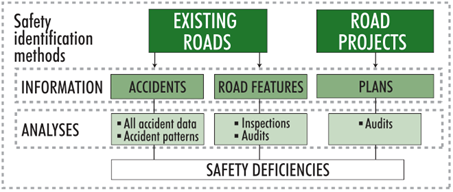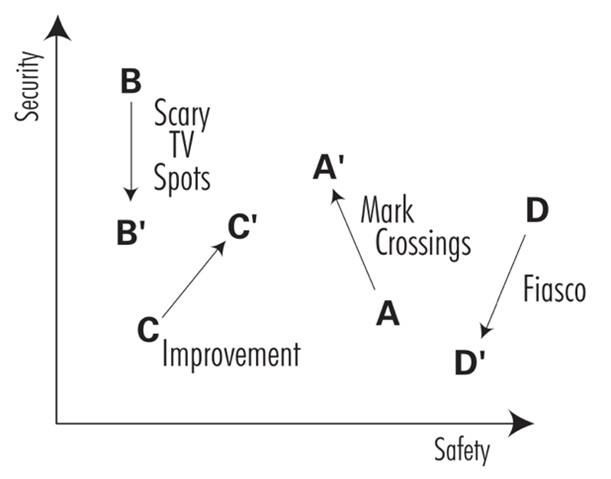10.2 PROGRAMME-LEVEL AND PROJECT- LEVEL APPROACHES
Road agencies typically allocate funding to improve high-risk locations, whether based on crash history or on the potential risk. This funding may take the form of dedicated funding for high-risk locations and/or be embedded in other operating budgets (for example, major projects or asset management). Most actions undertaken by a road agency have a safety impact, whether they are initiated for safety reasons or not. If consideration of safety is included in all decision-making, safety risk can be reduced, often at little or no additional cost. The assessment of risk needs to occur at the programme and project level, and the advice provided in this chapter is relevant to both.
The first difficulty encountered in implementing such a program is of a methodological nature. It consists in knowing how to identify dangerous sites. Objective identification methods that may be used by road administrations are summarized in the following diagram, extracted from Figure 10.19.

Social demand for road safety improvements can be expressed in four different ways, based on the nature of the hazard considered:
- Proven hazard (objective safety): measured objectively, based on crash statistics.
- Potential hazard (objective safety): scientifically assessed by measuring crash risk in relation to road characteristics and traffic levels.
- Experienced hazard (subjective safety): expressed subjectively by users, most often with a major deviation from proven or potential hazard.
- Intolerable hazard (subjective safety): types of crashes that are considered intolerable by society, even: e.g. crashes involving children, a vehicle crossing a freeway median.
There may be significant gaps between objective safety and subjective safety (also called ‘security’ - Figure 10.3). For example, Hauer (1997) explains that while marked crossings are perceived by road users as a safety improvement, they have been shown to be detrimental to safety (based on Herms, 1972).

Treatment of proven hazards and potential hazards (objective safety) uses the following scientific, rational methods:
- Crash data collection and processing.
- Objective identification methods:
- based on data,
- based on observations.
Treatment of experienced hazard or intolerable hazard (subjective safety) should be based on communication and information, in order to explain to road users and residents the consequences of actions they may have suggested. The following actions should be taken:
- Provide objective figures on crashes or risk and compare them with other situations.
- Explain advantages and disadvantages of solutions spontaneously suggested by users.
Various types of safety indicators may be used to detect and classify road hazards. These are discussed in more detail under Criteria for Selecting Locations to Investigate for Treatment.
Assessment of risk should be undertaken for the entire road network for which the road agency is responsible, based upon proven or objective hazard assessment. Such an approach would require a network-wide assessment of risks and issues. The outcomes of such an approach would identify key crash types, trends, geographic regions or areas, deficiency types, etc., with the outcomes of this assessment informing programmes of work.
It is often the case that a small percentage of roads account for a large percentage of deaths and serious injuries. At the programme-level, the task is to identify such routes and address these. For those countries with limited resources or that lack adequate data across the whole network, such locations are the most important to assess. These locations can form the basis of a corridor demonstration project. The content from this and the following chapters can be used as a guide to the assessment of risk across networks or along corridors. The examples shown in the case studies below provide information on the corridor approach in Belize and in New South Wales, Australia.
CASE STUDY - Belize: Corridor approach to risk assessment
As identified in the Case Study in section Linkage with Other Policies, Standards and Guidelines in Section 9.2 General Principles of Infrastructures Safety Management, although Belize is only a small country, it recorded 70 road traffic deaths in 2009, equivalent to 21 traffic deaths per 100,000 population. A multi-sector approach was taken to assessing road safety in Belize. Part of that project involved infrastructure improvements for a demonstration corridor. Read more
CASE STUDY - Australia: Corridor approach in New South Wales
Road safety infrastructure improvements on their own were not producing strong results in terms of fatal and serious injury reductions. New South Wales developed road safety reviews of major roads as a dedicated corridor approach to the analysis and selection of engineering works (and some behaviour change programmes) to improve road safety. Road safety reviews are different from engineering audits and high-risk location programmes. Read more
At a project level, the steps outlined in this chapter are equally relevant. They highlight how to identify risk at more specific locations (e.g. intersections, routes or areas) and diagnose risk at these locations. Crash-based (reactive) and more proactive approaches are relevant to both programme and project level approaches. In each case, whether programme or project level the same steps are involved in assessing risks and identifying casual issues. The Moldova used iRAP to assess risk, and the Czech Republic’s IDEKO research project developed method and tools for the treatment of hazardous locations.
CASE STUDY - Moldova: Improving pedestrian safety on Moldova's M2-R7 corridor
The Republic of Moldova State Road Administration wanted to rate 116 km of the M2-R7 corridor to understand how the road infrastructure influenced the likelihood and severity of crashes. Working from the design plans, the corridor was Star Rated in association with EuroRAP. The Star Rating design process provided a means of objectively measuring the impact on risk of various design iterations, and informed new safe design outcomes. Read more
CASE STUDY - Czech Republic: Identification of hazardous road locations
On each decision-making level a road safety management system should be established and operate. Such systems start with identification of hazardous road locations, followed by their analysis, priority setting, proposal and application of countermeasures, and evaluation of effectiveness. The national research project ‘IDEKO’ was undertaken by CDV - Transport Research Centre. Its objective was to develop methods and tools for identification and treatment of hazardous road locations. Read More






